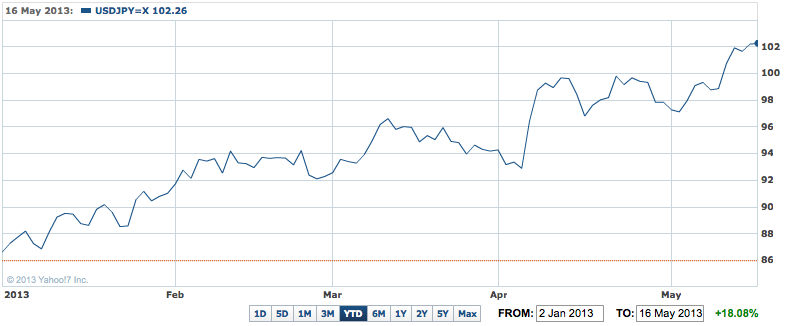The growing attraction of Japanese equities for big global investors (see – Global Investors Concerned About China) has been underlined by a sharp improvement in the health of the country’s economy in the three months to March this year.
It should be a development noted by investors large and small in Australia because a more vibrant Japan will go some way to offsetting the rising tide of doom and gloom about China. Japan is our second largest export market after China.
The first estimate of March quarter economic growth, released yesterday, shows Japan’s GDP rose 0.9% from the last quarter of 2012, when growth was updated to around 0.3% quarter on quarter (1% annual), from the previous estimate of a 0.1% drop (0.4% annualised).
That performance saw Japan comfortably in front of Europe, South Korea and the US in the first quarter – a rare event in recent years (except for the first quarter of last year). France slipped back into recession last quarter, Italy’s recession will depend with growth contracting by 0.5%. Germany could only manage growth of just 0.1% per cent. Spain’s economy contracted by 0.5%.
Japan’s growth also beat that of the US, whose first-quarter GDP expanded by an annualised 2.5% (according to the first estimate last month) and seems to be sliding in the current quarter.
Yen’s weakness boosts Japanese economic growth

Coupled with the significant upgrading of the December quarter figure (which was deflated by the Japanese statistics people not including the relevant seasonally adjusted data for some areas of activity), it’s clear the Japanese economy has been growing for six months, after contracting for the June and September quarters of 2012.
The government said yesterday that the rebound was driven by higher household spending and exports – just what the new expansionist policies of the Abe Government want to see happening.
Exports grew 3.8% in the quarter (as Japanese car makers took advantage of the lower yen to ship more cars to the US market), much more than the 1% rise in imports which were boosted by the high cost of LNG imports and higher imports of coal to meet the needs of the country’s power statins because of the continuing closure of many of Japan’s nuclear power plants.
Consumer spending rose 0.9% in the quarter, while government spending jumped 0.8%, and will rise further as the $A98 billion in extra government spending, agreed to in January, starts working its way through the economy.
The result beat expectations for a 0.7% quarter-on-quarter increase, and a 2.8% annualised expansion.
It is the strongest growth seen since the 6.1% annual jump in the March quarter of 2012, which was driven by stepped up spending in the earthquake and tsunami shattered north western coastal region.
Department store spending (a much more important sector in Japan than in Australia) rose to its highest level in March, while housing construction had its 7th consecutive month of expansion in the same month.
But it wasn’t all good news – in fact the negative parts of the report just underline the task in front of the government and the bank of Japan in getting Japanese economic growth back on track in a sustainable way.
Even though exports grew solidly in the quarter, that didn’t courage business to open their bank accounts and spend more on new facilities and plant. In fact private sector capital investment fell for the 5th quarter in a row – down 0.7%, even though that was half the 1.4% slump in the final months of last year.
And the biggest bugbear of all – deflation – remains in control of Japan.
The GDP deflator – a more accurate measure of inflation at all levels in the economy, was gain negative at minus 1.2%.
That’s the 14th straight quarter of deflation this time around – or three and a half years is misery. The question now is how long this will continue before it runs out of puff.













